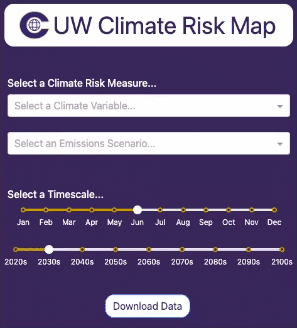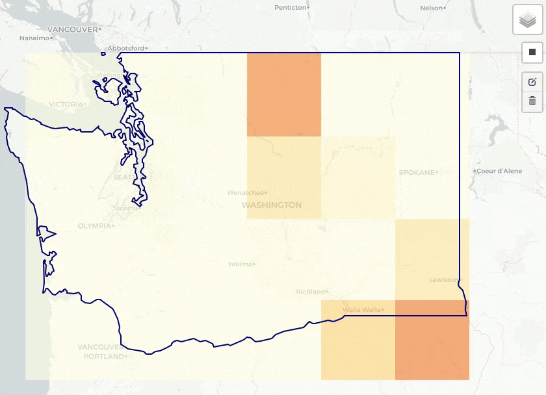CRL Map: Difference between revisions
Jump to navigation
Jump to search
m remove border on Download Data |
Start methodology and data source section |
||
| Line 71: | Line 71: | ||
|} | |} | ||
=== Download Data Output === | |||
= Methodology = | |||
This section provides an overview of how the Climate Risk Mapping Application is built and the methodology behind its calculations and data processing. | |||
== Data Sources == | |||
=== Climate === | |||
* '''% Area that is Covered by Burnt Vegetation''': This initial variable for the prototype is sourced from CMIP6 (Coupled Model Intercomparison Project Phase 6), which provides multiple scenarios of future climate conditions. | |||
Revision as of 22:44, 8 October 2024
Quick-Start Guide
Follow this step-by-step guide for a basic overview of the map functionality. The map can be accessed here.
Selecting Climate Scenario Parameters
First, we need to select a combination of parameters for the desired climate scenario.
The example on the right illustrates a scenario where the selected measure is "% Area Covered by Burnt Vegetation"—used as a proxy for wildfire risk—under a moderate emissions projection for August in the 2060s.
|
Selecting Infrastructure Overlays
Second, we need to select the specific types of infrastructure we are interested in visualizing.
|
Download Data
From here, you can explore the map and your particular areas of interest visually to get a sense of asset exposure. You may wish to download the data to do an offline analysis, which can be done easily.
|
Download Data Output
Methodology
This section provides an overview of how the Climate Risk Mapping Application is built and the methodology behind its calculations and data processing.
Data Sources
Climate
- % Area that is Covered by Burnt Vegetation: This initial variable for the prototype is sourced from CMIP6 (Coupled Model Intercomparison Project Phase 6), which provides multiple scenarios of future climate conditions.



